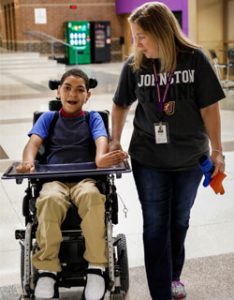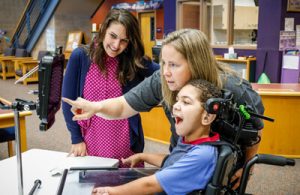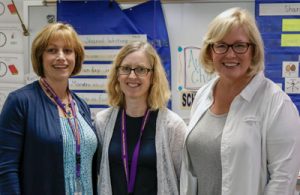Summit Student, Staff Break Down Communication Barriers
(Written and published by the Iowa Department of Education; all photos courtesy of the Iowa Department of Education)
Like most seventh graders, Tycin Gordon likes to tell jokes (good or otherwise).
“How does a deaf fish hear? With a herring aide!”
Unlike most seventh graders, Tycin is nonverbal. He communicates through technology.
Born with cerebral palsy, he has a motor disorder that makes speaking impossible in the traditional way. But when he entered kindergarten at Lawson Elementary School in the Johnston Community School District, Deb Gilmore was ready for him.
Gilmore, a special education teacher, had attended a class at the Iowa Department of Education on the use of a Pragmatic Organization Dynamic Display, or PODD, which is an augmentative or alternate communication system for people with complex communications needs.
PODD, which in the simplest form is hundreds of pictures displaying various words, enables those with an inability to speak traditionally to communicate.
“Before we had this, teachers would offer perhaps a picture of two different things,” Gilmore said. “As such, it was teacher focused, meaning that she was the one who was determining what was going to be said. Now, it is student focused because the student has the vocabulary.”
And that’s critical to learning.
“You have to start with communication,” said Ellie Holland, a speech and language pathologist with Heartland Area Education Agency. “Education hinges on the ability to communicate. If a kid needs technology to communicate, it moves his skill sets along.”
And to that end, communication enables the teacher to know where the student stands.
“You cannot observe cognition,” Gilmore said. “We have presumed competence, and realize that everyone has something to say. It comes down to finding the key to unlock communication.”
Even though Tycin’s vocabulary and comprehension grew, the word charts were still not enough. By the second grade, he was introduced to computer-generated speech. With a 
As the educators watched on as Tycin was learning the technology, they could see he was awestruck.
“He kept looking back at us, like he was saying, ‘Are you watching this? Are you watching this?’” Holland said.
Tycin was on a roll. With the technology, general education was no longer an obstacle to him. And that’s where the depths of his intelligence began to shine.
“They were in small groups learning about the Constitution,” Holland recalled. “And Tycin is answering the questions more quickly than the rest. He’s getting the answers right. I just remember a little girl in the group looking at me and saying, ‘he is really smart.’ And I said, ‘yes, yes he is.’”
Success in the general education classroom was a game changer.
“He was motivated being with his peers,” Gilmore said.
This outcome undoubtedly surprised some, said Pam Childers, Heartland’s professional learning and leadership consultant.
“It’s about not putting ceilings on kids,” she said. “A lot might make the inference that, ‘oh, he’s not verbal, so he can do just this.’ But we must presume competence. If we put limits on kids, they won’t get to where they can and need to be.”
“You have to have high expectations for all students,” Gilmore added.
Holland credits Gilmore for creating an inclusive environment at the elementary school.
“Deb’s really good at helping the staff and offering to help,” she said. “Deb is not afraid of going to gen. ed. teachers and get what her students need.”
“It’s really a matter of buy in,” Gilmore said. “When they see the child is communicating, they get that buy in.”
Gilmore stresses the importance for having an effective communication plan in place.
“Communication is the basis for all learning,” she said. “Without having a great communication plan, you’re not going to know that child’s personality, and they won’t be able to access core topics.”
With access to general education, there’s also that crucial social interaction.
“Tycin’s peers interact with him now,” Childers said. “Even during off times when class isn’t in session, they will go to him and strike up conversations.”
The educators agree that Tycin has come a very long way in a relatively short period of time.
“I think about Tycin when he had two pictures to choose from,” Holland said. “He’s moved from there to a thousand words to today’s speech-generating technology. His lexicon is 
“And he’s only in seventh grade,” Childers added.
“Think about his quality of life, and how that has improved, too,” Gilmore said. “When you see his peers communicating with Tycin, you get teary and goose-bumpy and you think, ‘yes, this is what it is all about.’”
Now at Summit Middle School, Tycin is thriving, said his special education teacher Leah Beeman.
“He’s smart and a bit ornery,” Beeman smiled.
Tycin grinned at this. And then, without missing a beat, he compels visitors: “Knock, knock…” Whose there? Yep, it’s Tycin.
